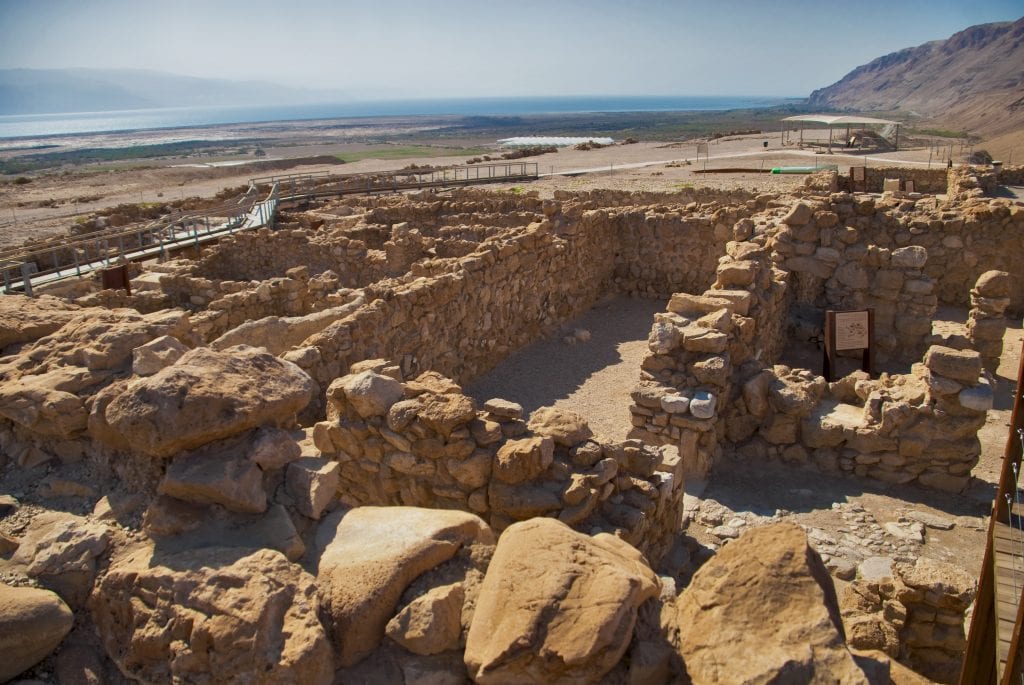A recently published study may have solved an ancient mystery that has puzzled archaeologists for decades: Qumran, thought to be a settlement of the Jewish of the Essenes on the shore of the Dead Sea, hosted many substantial public buildings but lacked any dwellings for people. Where did the people live? The answer is hidden in a passing reference in one of the Dead Sea Scrolls.
Qumran: Ancient mystery
Archaeologists believe Qumran was inhabited from about 135 BCE-68 CE and was destroyed by the Romans soon after. The 2,000-year-old Dead Sea Scrolls were discovered nearby and Qumran itself contained a scriptorium. In addition, several ritual baths, necessary for scribal work of holy literature, was also found. A nearby cemetery contains mostly the remains of males, leading researchers to believe the community was semi-monastic. Many scholars believe the location was home to a Hebrew sect, probably the Essenes.
The lack of actual dwellings has perplexed scholars with some theorizing the location was a fortress while others suggested the residents lived in tents or booths that would not leave remains. The large quantity of pottery remains suggested a not insubstantial population.
Dr. Daniel Vainstub of Ben-Gurion University of the Negev authored a study recently published in the peer-reviewed, open-access academic journal Religions. In his study, Vainstub theorized that Qumran was indeed an Essene site, though not a city that was constantly inhabited. He suggested that Qumran was a gathering point for Essenesto come from all over the country to hold their annual celebration of the “passing of the covenant.”
“I looked both at the texts and the archaeological remains, and what I have seen perfectly fits this possibility,” Vainstub said.
Dead Sea Scrolls, Damascus Document, and Manual of Disicipline
He bases his theory on references in the Dead Sea Scrolls referred to as the “Community Rule” manuscripts previously referred to as the Manual of Discipline. The document deals with such subjects as the admission of new members, and conduct at communal meals. The picture that emerges from the scroll is one of a communal, ascetic life governed by rigorous rules, which transformed the members of the Community into “priests in spirit,” who lived sacred lives in a “spiritual temple.”
The Damascus Document, a copy of the Community Rule created around the year 1,000 CE, was discovered in the Cairo Geniza in 1897. The fragments were quite large, and a number of them matched documents found later in Qumran. The textual relationship between the Damascus Document and Community Rule is not completely resolved, though there is a general agreement that they have some evolutionary connection.
Two essential elements are described in the Damascus Document but omitted in the Community Rule Document.
“The description of the ceremony in the Damascus Document includes a sentence containing two pieces of information that are of critical importance for our purposes and are missing in the Community Rule,” Vainstub wrote, quoting the document, “And all [the inhabitants] of the camps shall assemble in the third month and curse anyone who deviates either to the right [or to the left from the] Torah.”
Vainstub concluded that the document instructed the Essenes, who he referred to as the yaḥad sect, to gather in the month of Sivan when the festival of Shavuot takes place. He also understood this to mean that people from different places were called to gather in one site.
“It could be that Qumran was even built for the purpose of this gathering,” he wrote.
“Unlike any other group or philosophy in ancient Judaism, the yaḥad sect obliged all members of the sect to leave their places of residence all over the country and gather in the sect’s central site to participate in a special annual ceremony of renewal of the covenant between God and each of the members, Vainstub wrote. “The increase of the communities that composed the sect and their spread over the entire country during the first century BCE required the development of the appropriate infrastructure for hosting this annual gathering at Qumran. Consequently, the hosting of the gathering became the main function of the site, and the southern esplanade with the buildings surrounding it became the epicenter of the site.”
Since the gathering was annual and for a short period of time, the people would be housed in the countless caves that dot the region. These caves are where the Dead Sea Scrolls were found.
“My theory is also consistent with the fact that the scrolls did not necessarily originate from Qumran, but rather were brought to the caves from all over the country and were left in the caves over the decades,” Vainstub wrote.
Vainstub said the ceremony was a ceremony of renewal of the covenant between God and each member of the sect, described literally as “passing the covenant” and may have been modeled on the gathering of the Children of Israel at Mount Ebal and Mount Gerizim after they entered Israel. The celebration was an exclusively Qumranic event and was not observed in any other place or by any other people.
“All the members of the yaḥad gathered in one place and walked in line between the priests and the Levites,” Vainstub wrote. “The priests solemnly read the benedictions, the Levites read the curses and the members of the yaḥad expressed their consent by saying ‘Amen, amen!’”
“Some dozens of permanent residents of Qumran, perhaps with the help of small Essene groups living nearby close to the springs on the shores of the Dead Sea, had to host many hundreds of people at the site once a year in ever-increasing numbers,” Vainstub concluded in the paper. “The site of Qumran, with its facilities, caves and surfaces, accords with the evidence for the annual gathering that emerges from the scrolls. No other known site is suitable for such a purpose.”
The shortcode is missing a valid Donation Form ID attribute.




